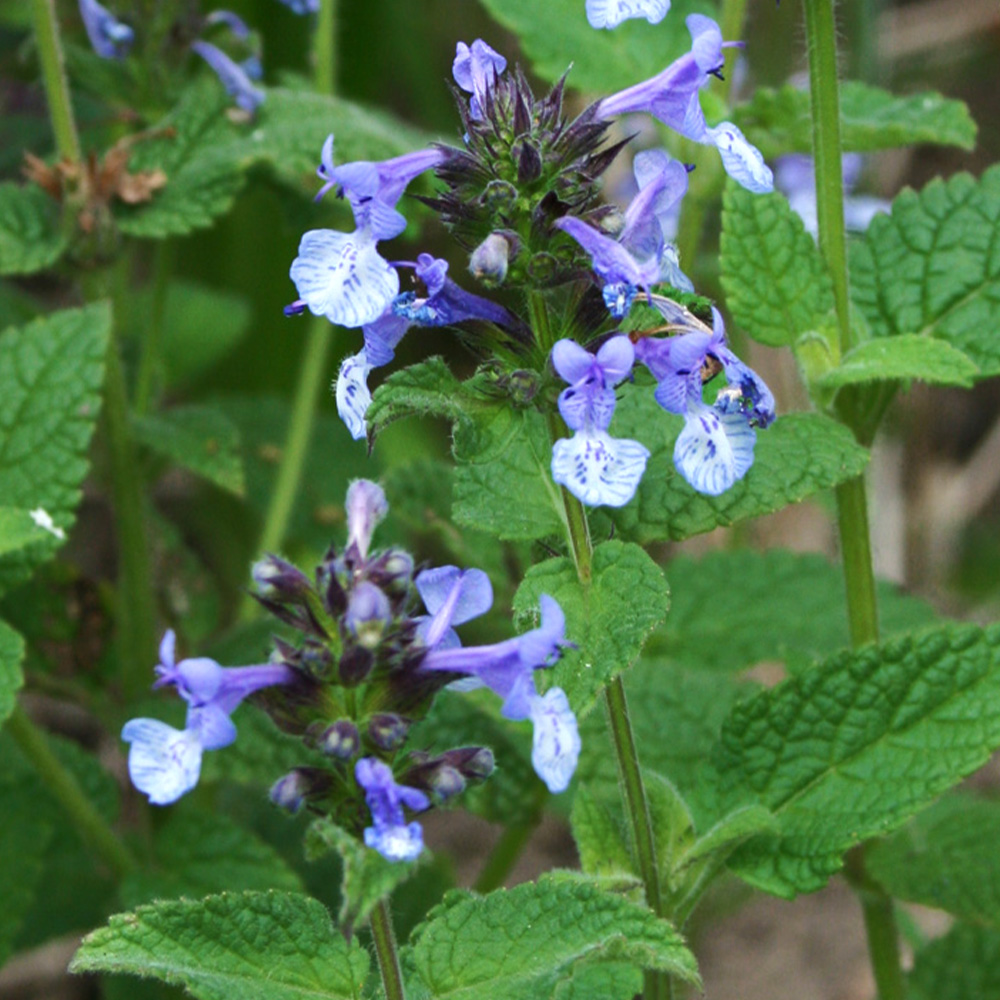No products in the cart.
Nepeta clarkei
Catnip from the mountains of Pakistan and India
Rated 0 out of 5
0 customer reviews
4,90 €
Only 23 item(s) left in stock!
Tags: aromatique, comestible, graphique, gris, longue floraison, perennial, vivace, vivace en pot
SKU: pda398
Category: Bees and Butterflies, Balcony-Friendly, Bouquet, Distillations, Fragrant, Frost Hardy, Grey Ladies, Medicinal, Rewild

Nepeta clarkei
4,90 €
Only 23 item(s) left in stock!
Nepeta clarkei is a perennial that forms a lovely clump of leafy stems, which are covered in early summer with small, delicately blue and white flowers.
The flowers are more complex than the other Nepeta flowers – they are bicolored, a lavendar blue overall color exposes a soft white throat as the flower grows.
The leaves are similar to the rest of the Nepeta family – crinkled, grey-green leaves, aromatic when crushed.
The stems are square in section and hairy near the base.
This has given the whole genus the nickname “catnip,” though the one with greater powers is the sister Nepeta cataria.
👩🌾GARDENING TIPS👩🌾:
-
- Himalayan Catmint, like other Nepeta species, is perfect for a low-maintenance garden that embraces nature.
- Very hardy, this species enjoys sunlight but dislikes overly dry soils, making it a true mountain dweller.
- Continuous blooming is encouraged by removing spent flowers.
- Make sure your soil is well draining, because while catnip can handle drought and frost – it cannot handle soggy roots!
- Looks great with: Sedum, Echinacea purpurea, Stachys byzantina, Achillea, Agastache
Discover more about gardening with Nepeta:
The Tales & The Botany: Nepeta clarkei
Nepeta clarkei’s natural habitat consists of rocky slopes and open sunny areas along streams and lakes, at altitudes of up to 3000m.
Why is it called catnip? The nepetalactone contained in some species of the genus Nepeta binds to the olfactory receptors of cats, usually causing temporary euphoria that makes them roll and shudder with pure joy.
🌸 Floral Morphology: Nepeta clarkei
The flowers of Nepeta clarkei grow in dense terminal spikes, forming a cloud of color at the stem tips.
Each flower is bilaterally symmetrical (zygomorphic), tubular, and approximately 1–2 cm long.
The corolla is two-lipped, with a short upper lip and a longer lower lip that acts as a landing platform for pollinators.
The four stamens are enclosed within the corolla tube, surrounding a single forked style.
Leaves are opposite, ovate to lanceolate, and lightly hairy, creating a soft, silvery-grey texture that enhances the plant’s visual appeal.
When brushed or crushed, the foliage releases a gentle aromatic scent, making it a delight for both the eyes and nose.
🌱 Reproductive Biology
Flowers are hermaphroditic, capable of self-pollination but naturally favoring cross-pollination by bees, butterflies, and hoverflies.
Fruits are small nutlets that can self-seed under ideal conditions, allowing the plant to naturalize slowly in suitable garden settings.
Blooming occurs from late spring to mid-summer, and deadheading may extend flowering slightly.
The flowers’ tubular structure and aromatic foliage make Nepeta clarkei particularly attractive to pollinators, adding both ecological and aesthetic value to the garden.
🌍 Ecology & Adaptations
Nepeta clarkei thrives in temperate and Mediterranean-style gardens, particularly in:
-
- Borders and rockeries: Adds soft color and texture with low, compact foliage.
- Pollinator-friendly beds: Produces abundant nectar for bees, butterflies, and hoverflies.
- Sunny, well-drained sites: Full sun encourages prolific flowering and compact growth, while the plant tolerates poor soils.
Key adaptations include:
-
-
💦 High drought tolerance once established: Hairy, silvery leaves reduce water loss and help the plant survive dry conditions.
-
☀️ Sun-loving: Performs best in full sun but tolerates partial shade.
-
👍 Low-maintenance: Aromatic foliage deters some pests, and the plant requires minimal care.
-
🌸 Long flowering period: Ensures continuous visual impact and nectar supply for several weeks.
-
💪 Self-supporting, compact habit: Ideal for front-of-border planting, rockeries, and container use.
-
Other Names:
Himalayan Catmint
Origin:
Pakistan, Kashmir, north-western India, and Tibet
| Weight | 0,5 kg |
|---|---|
| Flower Color | Lilac, 🔵 Blue |
| Flowering | June, July |
| Exposure | Full Sun |
| Frost Tolerance | -20°C to -25°C |
| Soil | Cool, Dry |
| Size | 0.6m H x 0.6m W |
Reviews
0
Rated 0 out of 5
0 customer reviews
5
0
4
0
3
0
2
0
1
0
Only logged in customers who have purchased this product may leave a review.
You may also like…
Salvia officinalis “Icterina”
A sage known for its colorful yellow and green foliage and aromatic properties.
A sage known for its colorful yellow and green foliage and aromatic properties.
Rated 0 out of 5
Nepeta x faassenii
Catnip is known for its grey-green, aromatic foliage and masses of lavender blue flowers.
Catnip is known for its grey-green, aromatic foliage and masses of lavender blue flowers.
Rated 0 out of 5
Geranium cinereum ‘Ballerina’
A dwarf hardy geranium with pink flowers from the mountains
A dwarf hardy geranium with pink flowers from the mountains
Rated 0 out of 5
Related Products
Jacobaea maritima
A wooly white perennial plant from the Mediterranean region.
A wooly white perennial plant from the Mediterranean region.
Rated 0 out of 5
Artemisia alba subsp camphorata
A highly fragrant, grey-green bush.
A highly fragrant, grey-green bush.
Rated 0 out of 5
Stachys byzantina
Silky white-grey leaves and tall striking flowers
Silky white-grey leaves and tall striking flowers
Rated 0 out of 5
Tanacetum densum subsp amani
A shrublet composed of soft, finely divided silvery gray-white leaves.
A shrublet composed of soft, finely divided silvery gray-white leaves.
Rated 0 out of 5
Aegopodium podagraria ‘Variegata’
A popular light, green and white groundcover.
A popular light, green and white groundcover.
Rated 0 out of 5
Artemisia abrotanum
A highly fragrant, medicinal and striking grey-green bush.
A highly fragrant, medicinal and striking grey-green bush.
Rated 0 out of 5
Potentilla anserina
A distinctly silvery, silky and lacy perennial.
A distinctly silvery, silky and lacy perennial.
Rated 0 out of 5
Helichrysum orientale
A perennial with soft, ash gray foliage and yellow button flowers
A perennial with soft, ash gray foliage and yellow button flowers
Rated 0 out of 5
Salvia officinalis
A fragrant herb used in many cultures for cooking and deserts.
A fragrant herb used in many cultures for cooking and deserts.
Rated 0 out of 5
Artemisia Valerie Finnis
A semi-evergreen, aromatic variation on the theme of Artemisia.
A semi-evergreen, aromatic variation on the theme of Artemisia.
Rated 0 out of 5
Salvia sclarea – Clary Sage
A fuzzy perennial that is largely grown for its essential oil.
A fuzzy perennial that is largely grown for its essential oil.
Rated 0 out of 5
Lavandula angustifolia
A highly aromatic, flowering perennial used for cooking in many cultures
A highly aromatic, flowering perennial used for cooking in many cultures
Rated 0 out of 5
Sedum spectabile Septemberglut
A species of flowering plant in the stonecrop family – drought tolerant, with vibrant pink flowers and a spectacularly long flowering period.
A species of flowering plant in the stonecrop family – drought tolerant, with vibrant pink flowers and a spectacularly long flowering period.
Rated 0 out of 5
Cerastium tomentosum var. columnae
A grey-green spreading ground cover from the mountains.
A grey-green spreading ground cover from the mountains.
Rated 0 out of 5
Mertensia maritima
A deciduous perennial with fleshy, blue-grey-green leaves that naturally thrives on the wind and sea swept coasts
A deciduous perennial with fleshy, blue-grey-green leaves that naturally thrives on the wind and sea swept coasts
Rated 0 out of 5
Stipa tenuifolia
A species of long, blonde, feathery grass.
A species of long, blonde, feathery grass.
Rated 0 out of 5
Euphorbia myrsinites
Known for its draping form of silver-gray foliage and radiant blooms.
Known for its draping form of silver-gray foliage and radiant blooms.
Rated 0 out of 5
Helichrysum italicum
An evergrey, fragrant perennial that will bring a distinctly Mediterranean atmosphere.
An evergrey, fragrant perennial that will bring a distinctly Mediterranean atmosphere.
Rated 0 out of 5
recent view product
Santolina chamaecyparissus
A fragrant, evergreyshrub with little yellow button flowers in summer
A fragrant, evergreyshrub with little yellow button flowers in summer
Rated 0 out of 5
Tradescantia sillamontana Variegata
A fuzzy, bright yellow, drought-resistant, indoor plant
A fuzzy, bright yellow, drought-resistant, indoor plant
Rated 0 out of 5
Centranthus ruber Albus
A wonderfully resilient perennial, producing white panicles all summer long.
A wonderfully resilient perennial, producing white panicles all summer long.
Rated 0 out of 5
Geranium Dreamland
Bright green foliage and delicate white flowers with light pink veins
Bright green foliage and delicate white flowers with light pink veins
Rated 0 out of 5
Sedum morganianum ‘Burrito’
A lovely succulent that develops thick trailing stems covered with overlapping, plump, blue-green leaves as it grows.
A lovely succulent that develops thick trailing stems covered with overlapping, plump, blue-green leaves as it grows.
Rated 0 out of 5



















































There are no reviews yet.